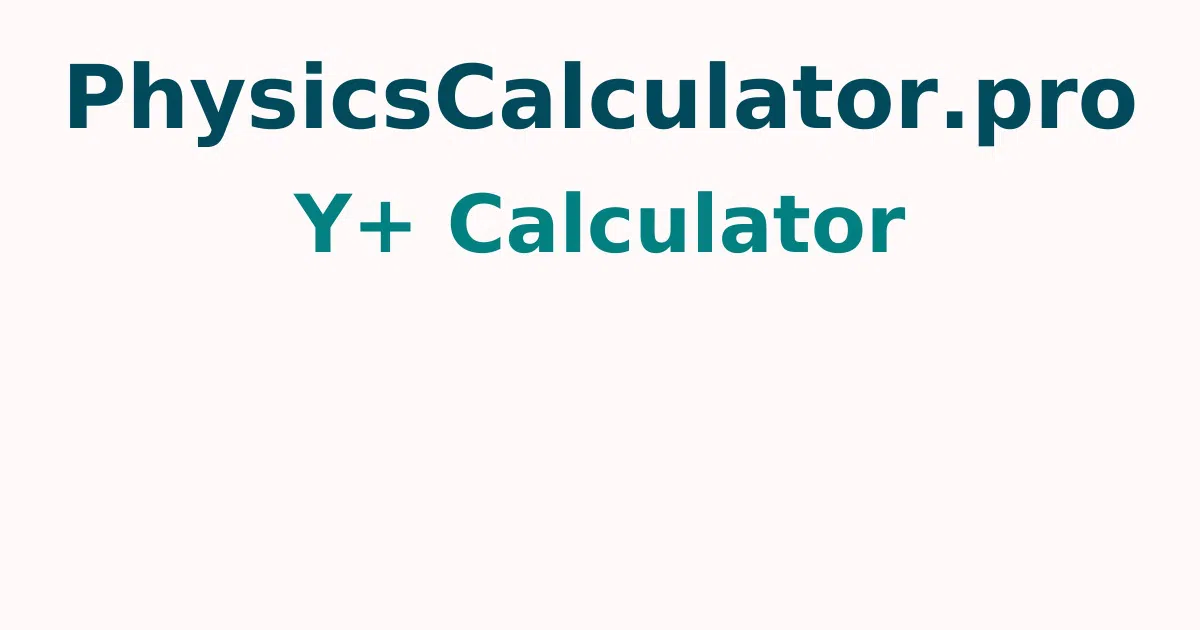Y+ Calculator
The y+ calculator can help you to find out how much wall space you'll need for your CFD simulation. Fluid movement near the wall is a difficult phenomenon to understand. To calculate the fluid flow parameters near a surface or wall, several models and assumptions are recommended. Such approximations and answers are used by a CFD application to give us an overall view of fluid flow around the object or on a surface.
What is a Boundary Layer?
Let's first define the boundary layer. Consider the movement of fluid over a flat plate. Boundaries refer to the plate's edges that come into touch with the fluid. Certain particles will adhere to the plate's boundary while a fluid, such as air, is flowing across it. Those particles near the boundary would have the same velocity as the barrier in that situation. If the boundary is at rest, it may even be zero.
The boundary layer refers to the relatively small region of fluid particles near the boundary. There are three subregions or layers that make up the border layer:
- Laminar boundary layer
- Transition region
- Turbulent boundary layer
We can see that when we travel away from the boundary, the particle's velocity is governed by the gradient, du/dy.
The fluid velocity, also known as free stream velocity, eventually reaches this point. The shear resistance is caused by the velocity gradient, which generates a very thin layer of fluid near the boundary. The boundary layer's thickness starts at zero at the edge and grows as one advances away from it.
The laminar boundary layer is the region where the thickness is exceedingly thin. It is only taken into account until the flow becomes laminar. Reynold's number can be used to determine the flow type. Beyond this threshold in the laminar boundary layer, the retarded fluid flow thickens the boundary layer to the point where it becomes unstable, resulting in erratic fluid particle motion. This layer is called the turbulent boundary layer.
The transition zone is defined as the area between two levels where the transition takes place. The shear stress along the wall is computed using the y+ wall thickness or wall functions technique or modelling strategy to obtain an approximate solution to the behaviour of fluid particles in the relatively close region of the turbulent boundary layer.
Y+ Formula or Boundary wall thickness Formula
y+ = yρu*/ μ
- Hence y = wall distance
- u* = friction velocity
- ρ = density of the fluid
- μ = dynamic viscosity
How can I find out the y+ wall distance?
The following procedure is used to find out the y+ wall distance:
- Step 1: Multiply the dynamic viscosity by the dimensionless thickness, y+.
- Step 2: Divide the result by the fluid's density.
- Step 3: Divide the result from the friction velocity.
Become familiar with plenty of similar concepts of physics along with well designed calculator tools complementing the concept on Physicscalculatorpro.com a trusted reliable portal for all your needs.
FAQs on y+ Calculator
1. What is the value of Y+ CFD?
A non-dimensional distance is y+. It is frequently used to characterise the coarseness or fineness of a mesh for a specific flow pattern. In turbulence modelling, determining the right size of cells near domain walls is critical. The y+ value at the wall is restricted by the turbulence model wall rules.
2. What should y+ represent?
To ensure that we are catching the laminar sub-layer while utilising low-Re models or any models with increased wall treatment, the average Y+ value must be on the order of 1. To avoid incorrect modelling in the buffer layer and laminar sub-layer when utilising wall function models, the Y+ value must ideally be greater than 15.
3. What are the different types of wall functions?
Wall functions are equations that have been obtained empirically and are used to fulfil the physics in the near-wall area. To ensure the correctness of the results, the first cell centre must be located in the log-law region. Wall functions are utilised to connect the inner part of the wall to the fully developed turbulent region.
4. Is OpenFOAM a free programme?
Under the GNU General Public License Version 3, there are three primary varieties of OpenFOAM software that are available as free and open-source software. These are the versions in chronological order: OpenCFD Ltd's OpenFOAM version.
